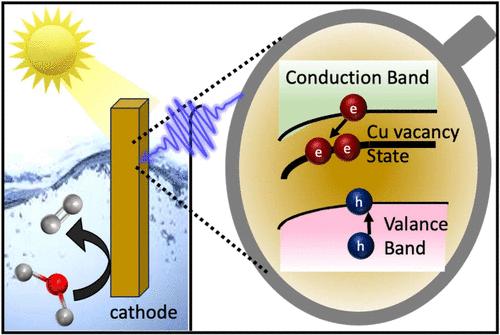当前位置:
X-MOL 学术
›
ACS Appl. Mater. Interfaces
›
论文详情
Our official English website, www.x-mol.net, welcomes your
feedback! (Note: you will need to create a separate account there.)
Effect of Surface Electron Trapping and Small Polaron Formation on the Photocatalytic Efficiency of Copper(I) and Copper(II) Oxides
ACS Applied Materials & Interfaces ( IF 8.3 ) Pub Date : 2024-07-25 , DOI: 10.1021/acsami.4c03941 Savini Bandaranayake 1 , Ananya Patnaik 1 , Emily Hruska 1 , Quansong Zhu 1 , Subhajit Das 1 , L Robert Baker 1
ACS Applied Materials & Interfaces ( IF 8.3 ) Pub Date : 2024-07-25 , DOI: 10.1021/acsami.4c03941 Savini Bandaranayake 1 , Ananya Patnaik 1 , Emily Hruska 1 , Quansong Zhu 1 , Subhajit Das 1 , L Robert Baker 1
Affiliation

|
Cu2O, CuO, and mixed phase Cu2O/CuO represent promising candidates for photoelectrochemical H2 evolution due to their strong visible light absorption, earth-abundance, and chemical stability. However, the photoelectrochemical efficiency in these materials remains far below the theoretical limit, largely due to poorly understood surface electron dynamics. These dynamics depend on defect states, such as Cu atom vacancies and phase boundaries, which control electron trapping, charge carrier separation, and recombination. In this work, we study the photoinduced electron and hole dynamics at the surface of various Cu oxides using ultrafast extreme ultraviolet reflection–absorption (XUV-RA) spectroscopy. In Cu2O we find that photoexcitation occurs as electron promotion from primarily Cu 3d valence band to Cu 4s conduction band states compared to O 2p valence band to Cu 4s conduction band states in CuO. In catalysts with a significant concentration of Cu vacancies, we observe fast electron trapping to the Cu 3d defect band occurring in less than 100 fs. In contrast, photoexcited electrons in phase pure CuO do not trap to midgap states; rather these electrons form small polarons within approximately 500 fs. Photoelectrochemical measurements of these catalysts show that Cu vacancy-mediated electron trapping correlates with a significant loss of photocurrent. Together, these results provide a detailed picture of the defect states and associated ultrafast carrier dynamics that govern the photocatalytic efficiency in widely studied Cu2O and CuO photocatalysts.
中文翻译:

表面电子俘获和小极化子形成对铜(I)和铜(II)氧化物光催化效率的影响
Cu 2 O、CuO和混合相Cu 2 O/CuO由于其强可见光吸收、地球丰度和化学稳定性而成为光电化学H 2析出的有前途的候选材料。然而,这些材料的光电化学效率仍然远低于理论极限,这很大程度上是由于对表面电子动力学知之甚少。这些动力学取决于缺陷态,例如铜原子空位和相界,它们控制电子捕获、载流子分离和复合。在这项工作中,我们使用超快极紫外反射吸收(XUV-RA)光谱研究了各种铜氧化物表面的光生电子和空穴动力学。在Cu 2 O中,我们发现光激发主要是由于电子从Cu 3d价带提升到Cu 4s导带态而发生,而CuO中的光激发是O 2p价带提升到Cu 4s导带态。在具有高浓度 Cu 空位的催化剂中,我们观察到在不到 100 fs 的时间内发生快速电子捕获到 Cu 3d 缺陷带。相比之下,纯 CuO 中的光激发电子不会俘获到中带隙态;相反,这些电子在大约 500 fs 内形成小极化子。这些催化剂的光电化学测量表明,铜空位介导的电子捕获与光电流的显着损失相关。总之,这些结果提供了缺陷态和相关超快载流子动力学的详细图片,这些动力学控制了广泛研究的 Cu 2 O 和 CuO 光催化剂的光催化效率。
更新日期:2024-07-25
中文翻译:

表面电子俘获和小极化子形成对铜(I)和铜(II)氧化物光催化效率的影响
Cu 2 O、CuO和混合相Cu 2 O/CuO由于其强可见光吸收、地球丰度和化学稳定性而成为光电化学H 2析出的有前途的候选材料。然而,这些材料的光电化学效率仍然远低于理论极限,这很大程度上是由于对表面电子动力学知之甚少。这些动力学取决于缺陷态,例如铜原子空位和相界,它们控制电子捕获、载流子分离和复合。在这项工作中,我们使用超快极紫外反射吸收(XUV-RA)光谱研究了各种铜氧化物表面的光生电子和空穴动力学。在Cu 2 O中,我们发现光激发主要是由于电子从Cu 3d价带提升到Cu 4s导带态而发生,而CuO中的光激发是O 2p价带提升到Cu 4s导带态。在具有高浓度 Cu 空位的催化剂中,我们观察到在不到 100 fs 的时间内发生快速电子捕获到 Cu 3d 缺陷带。相比之下,纯 CuO 中的光激发电子不会俘获到中带隙态;相反,这些电子在大约 500 fs 内形成小极化子。这些催化剂的光电化学测量表明,铜空位介导的电子捕获与光电流的显着损失相关。总之,这些结果提供了缺陷态和相关超快载流子动力学的详细图片,这些动力学控制了广泛研究的 Cu 2 O 和 CuO 光催化剂的光催化效率。

















































 京公网安备 11010802027423号
京公网安备 11010802027423号